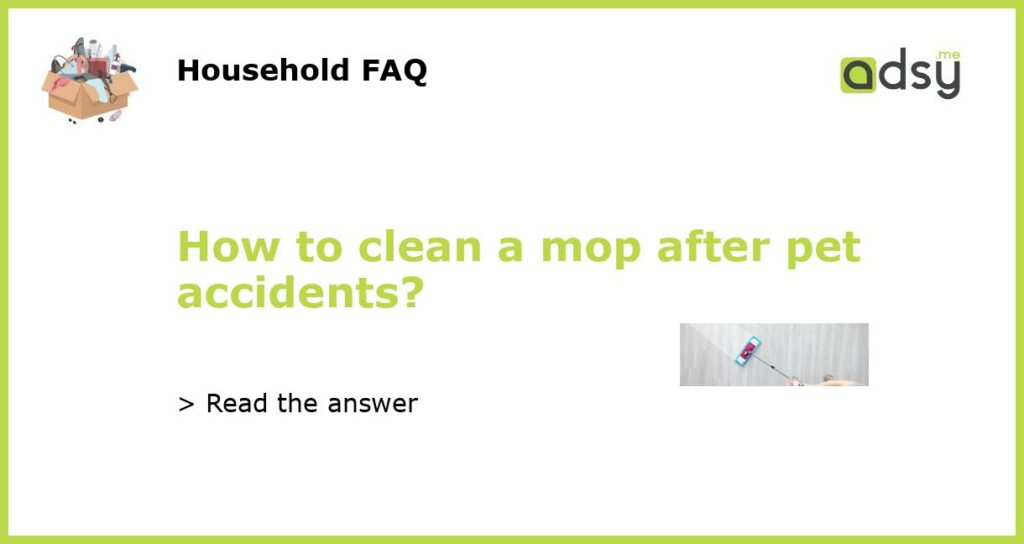Understanding the Importance of Cleaning Your Mop after Pet Accidents
If you are a pet owner, you know that accidents happen. Whether it’s a dog that hasn’t been fully potty trained or a cat that has an upset stomach, cleaning up after your furry friend is an inevitable part of pet ownership. One area that often gets overlooked is cleaning the mop after handling a pet accident. This is a crucial step in maintaining cleanliness and preventing the spread of bacteria and odors. In this article, we will discuss why it is important to clean a mop after pet accidents and provide helpful tips and techniques to ensure your mop is ready for future use.
The Dangers of Neglecting to Clean Your Mop
Many pet owners may not realize the potential dangers of neglecting to properly clean their mop after handling pet accidents. When a mop is used to clean up urine, feces, or other bodily fluids, it becomes a breeding ground for bacteria and germs. These microorganisms can multiply and contaminate your mop, making it an ineffective tool for future cleaning tasks. Additionally, the smell of urine or feces can become embedded in the mop fibers, creating an unpleasant odor that can be difficult to eliminate. By neglecting to clean your mop after pet accidents, you are putting yourself at risk of spreading germs and living with lingering odors.
Step-by-Step Guide to Cleaning Your Mop after Pet Accidents
Cleaning your mop after handling a pet accident doesn’t have to be a daunting task. By following these simple steps, you can ensure that your mop is thoroughly cleaned and ready for future use:
Step 1: Rinse the mop – Start by rinsing the mop under running water to remove any visible debris and pet waste. This will help prevent the spread of bacteria and make the subsequent cleaning process more effective.
Step 2: Soak the mop – Fill a bucket or sink with hot water and add a disinfectant solution, such as bleach or vinegar. Submerge the mop completely in the solution and allow it to soak for at least 15-30 minutes. This will help kill any remaining bacteria and eliminate odors.
Step 3: Scrub the mop – After soaking, use a scrub brush or your hands to agitate the mop fibers and remove any stubborn stains or residue. Pay special attention to any areas that were heavily soiled during the pet accident.
Step 4: Rinse again – Once you have thoroughly scrubbed the mop, rinse it again under running water to remove any remaining cleaning solution and debris. This will ensure that no harmful chemicals or bacteria are left behind.
Step 5: Allow the mop to air dry – Finally, hang the mop in a well-ventilated area to air dry completely. Avoid placing it in a closed space, as this can promote the growth of mold and mildew.
Tips and Tricks for Maintaining a Clean Mop
Keeping your mop clean and fresh-smelling after pet accidents is an ongoing process. Here are some additional tips and tricks to help you maintain a clean mop:
Tip 1: Use hot water – Whenever possible, use hot water when cleaning your mop. Hot water helps to dissolve and remove dirt and grime more effectively than cold water.
Tip 2: Use a pet-safe disinfectant – If you prefer to use a disinfectant solution, make sure it is safe for use around pets. Some cleaning products may contain harmful chemicals that can be toxic to animals.
Tip 3: Clean your mop regularly – Even if you haven’t had any recent pet accidents, it’s a good idea to clean your mop on a regular basis to prevent the buildup of bacteria and odors. Aim to clean your mop at least once a month, or more frequently if needed.
Tip 4: Store your mop properly – After each use, make sure to rinse and wring out your mop thoroughly before storing it. This will help prevent the growth of mold and mildew and keep your mop in good condition.
Tip 5: Consider using microfiber mop heads – Microfiber mop heads are known for their superior cleaning ability and ability to trap and remove dirt and bacteria. Consider investing in a microfiber mop head for optimal cleaning performance.
Conclusion
Cleaning your mop after pet accidents is an essential part of maintaining cleanliness and preventing the spread of bacteria and odors. By following the steps outlined in this article and incorporating the tips and tricks provided, you can ensure that your mop remains clean, fresh-smelling, and effective for future use. Remember, a clean mop is not only more hygienic but also more efficient in keeping your floors clean and free of pet-related messes.






